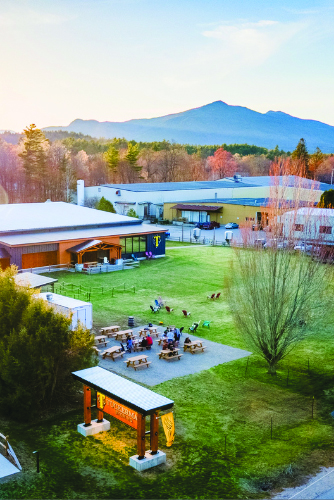Owner/Baker, Big Trees Baking Company
“I make sourdough bread, which I sell at some local stores and at the Canterbury Farmers’ Market,” Bartilucci said. “I have always loved baking; my mother and I baked growing up. Two years ago in 2023, when I moved to Canterbury, I decided to not buy store-bought bread anymore for the year and it turned into a little obsession. So I went to my farmers market board with bread samples and asked if they wanted a vendor. They … brought my bread around to all the other vendors to try it and everyone was so warm and welcoming. They wanted me to come back the next week to start selling, so I went home and got my watercolors out, made my logo that night and I’ve been selling at the market ever since.”
What is your must-have kitchen item?
My bench scraper. It’s a CDK bench scraper and it’s the larger size. It’s pretty much an extension of my hands. It helps me cut the dough, shape the dough, and transfer the dough. It does absolutely everything.
What would you have for your last meal?
Honestly, bread. I make bread and eat it all the time, but I do truly love bread that much. The other day we actually had an old-world sourdough with a friend around our countertop talking and we put sesame oil, avocados and sesame seeds on it and it was absolutely delicious.
What is your favorite local eatery?
I really enjoy Curry Leaf [in Concord]. I love their Malai Kofta. It’s absolutely delicious.
Who is a celebrity you would like to see eating your bread?
I guess more of a celebrity in the baking world would be James Bridges. He’s in charge of a lot of sourdough Facebook groups and Sourdough Geeks (sourdoughgeeks.com), which is a whole website and group devoted to sourdough baking. He does a lot of classes and education. He’s absolutely incredible at what he does.
Have you given your sourdough starter a name?
I have. Its name is Pineapples. When you start making a sourdough starter it smells like dirty socks at first, but after a while it gets this very yeasty fruity smell because it’s a little more on the acidic side as the good bacteria wins out. It reminded me of pineapples and that name just stuck.
What is a baking trend you see in New Hampshire right now?
Sourdough. Everyone’s making bread from home. People are really embracing that. And I think recognizing how important the farmers markets are and being able to bring their food to those and expand that local market.
What is your favorite thing to cook at home?
Anything with tofu and veggies. I’ve actually been putting tofu in the air fryer lately, just plain. And then it creates this little bit of crisp on the outside and almost gives it a subtle flavor to it. You have to use extra-firm tofu.
What do you put on your bread?
I use a lot of jam. Lindon Garlic Farm [in Gilmanton] makes a black garlic jam with blueberries or strawberries that is absolutely incredible.
What is a good resource for someone who is just learning to make their own sourdough bread?
There are a few people I would look into, actually. Tom Cucuzza, who does the Sourdough Journey (thesourdoughjourney.com), is a good one to start with. I like things in word form instead of video, and he does that well. And then there’s Maurizio Leo (theperfectloaf.com). He has a blog, he has books, he has everything. He’s very, very clear. He was an engineer prior to becoming a baker, so he kind of combines that scientific and artistic element of sourdough. Finally, the Sourdough Geeks Facebook group (facebook.com/groups/sourdoughgeeks) is a really good resource. You do have to look — I think the biggest thing is to look at people’s, the people that comment on your posts and give you advice, look at what their bread looks like and decide if it’s what you want yours to look like.
Featured Image: Tara Bartilucci. Courtesy photo.






